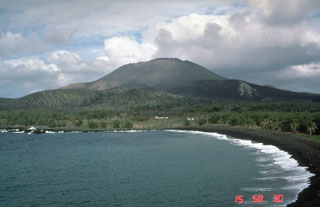Report on Pagan (United States) — October 1990
Bulletin of the Global Volcanism Network, vol. 15, no. 10 (October 1990)
Managing Editor: Lindsay McClelland.
Pagan (United States) Strong SO2-rich plume but no significant deformation or earthquake activity
Please cite this report as:
Global Volcanism Program, 1990. Report on Pagan (United States) (McClelland, L., ed.). Bulletin of the Global Volcanism Network, 15:10. Smithsonian Institution. https://doi.org/10.5479/si.GVP.BGVN199010-284170
Pagan
United States
18.13°N, 145.8°E; summit elev. 570 m
All times are local (unless otherwise noted)
A seven-member team of USGS volcanologists visited the CNMI 24 September-6 October at the request of the Office of Civil Defense. The team installed [a seismic station on] Pagan; data are telemetered to Saipan and recorded at Civil Defense headquarters. Quoted material below is from a report by Richard Moore.
"Remeasurements of the distances between two permanent glass reflectors installed in 1983 on the SW flank showed no significant changes in line lengths since 1984. Seismic data telemetered to Saipan showed no significant earthquake activity on Pagan after installation of the station in early October. Most of the abandoned village has been destroyed by alluvial debris derived from 1981 and younger rocks. Eruptions less vigorous than that of 15 May 1981 occurred intermittently from late May 1981 until October 1988. The USGS team observed a prominent SO2-bearing plume emitted from Pagan 28 September-3 October."
Geological Summary. Pagan Island, the largest and one of the most active of the Mariana Islands volcanoes, consists of two stratovolcanoes connected by a narrow isthmus. Both North and South Pagan stratovolcanoes were constructed within calderas, 7 and 4 km in diameter, respectively. North Pagan at the NE end of the island rises above the flat floor of the northern caldera, which may have formed less than 1,000 years ago. South Pagan is a stratovolcano with an elongated summit containing four distinct craters. Almost all of the recorded eruptions, which date back to the 17th century, have originated from North Pagan. The largest eruption during historical time took place in 1981 and prompted the evacuation of the sparsely populated island.
Information Contacts: R. Moore, USGS; R. Koyanagi and M. Sako, HVO.

